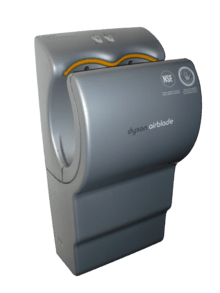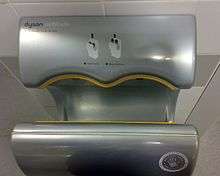Dyson Airblade
 | |
| Launch year | 2006 |
|---|---|
| Company | Dyson |
| Availability | Available |
The Dyson Airblade is a model of electric hand dryer made by the Wiltshire, UK based company Dyson.[1] It was introduced in the UK in 2006 and in the United States in latter part of 2007.
Description
Instead of using a wide jet of heated air, it uses a thin layer of unheated air traveling at around 400 mph (180 m/s; 640 km/h) as a squeegee to remove water, rather than using heat to evaporate the water.[2] The Dyson Airblade is claimed by its manufacturer to dry hands in 10 seconds and to use less electricity than conventional hand dryers.[1]
The first commercially available high-speed, horizontal-wiping air dryer was the Mitsubishi Jet Towel, invented in 1993 and available in the United States since 2005.[3] There are several technical differences among electric hand dryers, such as airspeed, water containment, energy efficiency, use of heat, type of filter, motor lifespan and power usage.[4]
Since its release, the Dyson Airblade has won several awards[5] including the Best Overall Product at Interbuild 2007[6] and Best workplace product innovation.[7]
The same technology is used by Dyson in the Air Multiplier fan to create a cooling air stream for personal comfort.
Energy efficiency
The Airblade can be more energy-efficient than conventional hand-dryers because it does not use electric heating; it also can run for a shorter time than conventional driers.
Drying time
A comparative test found that both paper towels and the Airblade dried hands quickly, achieving 90% dryness in about ten seconds, supporting Dyson's claim of ten seconds drying time. A conventional warm air dryer took 47 seconds.[8]
Hygiene

In the United States, Dyson worked with the NSF to become the only certified hand dryer under Protocol P335 for Hygienic Commercial Hand Dryers[9][10] The Royal Society of Public Health has given the Dyson Airblade hand dryer its first hygiene accreditation.
A paper was presented at the 17th European Congress of Clinical Microbiology and Infectious Diseases, Munich, Germany in 2007 by the University of Bradford and Dyson showing that for a set drying time of 10 seconds, the Airblade led to significantly less bacterial transfer than with the other driers (p < 0.05). When the latter were used for longer (30–35 s) the trend was for the Airblade to still perform better; however, these results did not reach statistical significance (p > 0.05). In addition the study showed that rubbing hands whilst using the driers counteracted the reduction in overall bacterial numbers at all anatomical sites.[11]
Hygiene associated with the product has been questioned in research by the University of Westminster Trade Group, London and sponsored by the paper towel industry the European Tissue Symposium, which suggests that use increases the amount of bacteria on the fingertips by about 42%; paper towels reduced the number of bacteria by 50 to 75%, while warm air dryers increased bacteria by 194%. The report found that "the manufacturer’s claim that the tested JAD [Airblade] is 'the most hygienic hand dryer' is confirmed ... assuming that the term 'hand dryer' refers to electric devices only because its performance in terms of the numbers of all types of bacteria remaining on the hands of users compared to paper towels was significantly worse."[8]
Model history

In early 2013, three new models of the Dyson Airblade were introduced: the Airblade Mk. 2, the Airblade V, and the Airblade Tap. The Mk. 2 uses a similar design as the original model, but has increased jet air speed from 400–430 mph (180–190 m/s; 640–690 km/h), and new soundproofing makes the new model quieter than the old one. The Airblade V is a hands-under hand dryer that complies with the Americans With Disabilities Act.
The Airblade Tap is a non-contact bathroom faucet that both washes and dries hands. It eliminates the need to move to a separate area to dry hands, and therefore eliminates any water dripped on the floor.[12] All three hand dryers use a new Digital Slim Motor, the Dyson V4.
| Model | Year | Features |
|---|---|---|
| Airblade AB01 | 2006 | 400 mph (180 m/s; 640 km/h) airspeed; discontinued |
| Airblade AB03 | 2006 | 400 mph (180 m/s; 640 km/h) airspeed; discontinued |
| Airblade Mk2 AB06/AB07/AB14 | 2013 | 430 mph (190 m/s; 690 km/h) airspeed[13] |
| Airblade V AB08 | 2013 | "hands-under" design; 430 mph (190 m/s; 690 km/h) airspeed |
| Airblade Tap AB09, AB10, AB11 | 2013 | automatic non-contact faucet with integrated hand dryer |
Controversies
On December 5, 2012, a lawsuit by competitor Excel Dryer was filed against Dyson, claiming that Dyson's advertising comparing the Airblade to the Excel Dryer XLERATOR are deceptive.[14] Dyson's advertisements state the XLERATOR produces twice as much carbon dioxide, is worse for the environment, and costs more to operate than the Airblade. Excel Dryer claims that Dyson was falsifying its comparisons by submitting a 20-second dry time for the XLERATOR to the Materials Systems Laboratory at the Massachusetts Institute of Technology, rather than Excel Dryer's tested 12-second dry time, thus inflating energy consumption figures in the Airblade's favor.
References
- 1 2 "Dyson unveils faster hand dryer". BBC News. 2006-10-03. Retrieved 2008-01-05.
- ↑ "Dyson's Airblade dries hands with 400MPH blast of air". 2006-10-03. Retrieved 2008-01-05.
- ↑ Mitsubishi Jet Towel November 27, 2009 Robin No comments (2009-11-27). "Mitsubishi Jet Towel". Fastlec. Retrieved 2011-04-10.
- ↑ Mitsubishi Jet Towel vs. Dyson Airblade Pre-Game Trash Talk and Tale of the Tape
- ↑ Dyson's Airblade Website
- ↑ "Dyson Airblade awarded Best Overall Product at Interbuild". Archived from the original on June 30, 2009. Retrieved 2008-01-05.
- ↑ "Innovation Awards". Retrieved 2008-01-05.
- 1 2 A comparative study of three different hand drying methods: paper towel, warm air dryer, jet air dryer’ by Keith Redway and Shameem Fawdar of the School of Biosciences, University of Westminster London
- ↑ "NSF PROTOCOL P335 Hygienic Commercial Hand Dryers". Nsf.org. Retrieved 2011-04-10.
- ↑ "Questions & Answers about the new NSF Protocol P335'" (PDF). Archived from the original (PDF) on November 26, 2010. Retrieved 2011-04-10.
- ↑ Snelling, AM; Saville, T; Stevens, DG; Beggs, CB (2007-04-02), Evaluation of a new ultra-rapid hand drier in relation to hand hygiene, retrieved 2014-09-30
- ↑ "Dyson Airblade Tap hand dryer". Dyson airblade. Retrieved 2015-03-28.
- ↑ New Dyson Airblade Hand Dryers 2013
- ↑ Case 3:12-cv-30211-MAP - Docstoc
